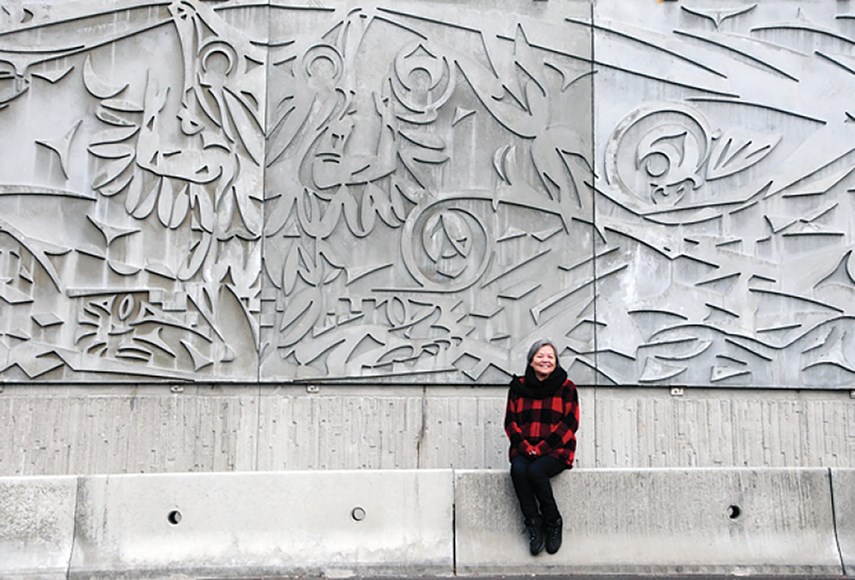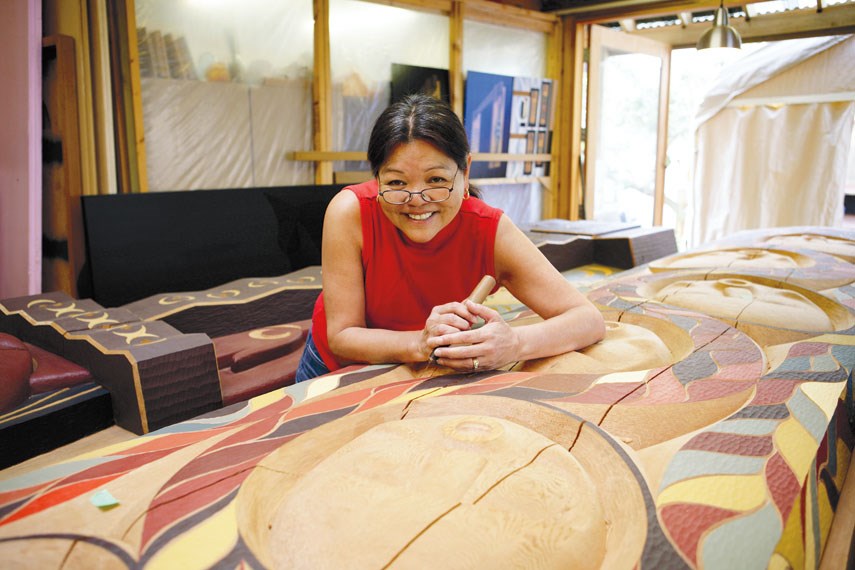Susan Point and the Renaissance of Coast Salish Art with author Robert D. Watt, North Vancouver District Library, Lynn Valley branch, Wednesday, Oct. 16, 7 p.m. Registration required. Register online (nvdpl.ca) or call 604-984-0286, ext. 8144.
On one side: heavy industry and workers making a living. On the other side: life.
Stretching along the Low Level Road over 130 metres is the Story of Life, artist Susan Point’s mural of butterflies frogs, flora, fauna, and two figures, “welcoming all peoples to this land.”
While not easing gridlock, the panels may have eased the minds of the gridlocked since its installation in 2014.
“Even though there is repetition to the imagery, it gives a different appeal from both directions,” Point explains.
Point’s pocket-sized description of her life-sized work is included in People Among the People, a recently published reference book.
Written by Robert D. Watt and replete with photographs by Kenji Nagai, the book is both a celebration of Point’s work as well as a chronicle of her craftsmanship. The $50 hardcover – too big for the bus and too heavy to handle with one hand – includes extensive commentary from Point.
“I am mostly inspired by nature and our connected ‘human spirit,’” Point writes. “I try to illustrate our need to protect and restore our natural treasures . . .”
Point’s work – which has spanned cedar, stainless steel, paper and glass – can be seen all over Metro Vancouver and beyond. But 40 years ago, Watt couldn’t find anything like it.
In 1981 Watt was a committee member hoping to add some Indigenous art to the City of North Vancouver’s forthcoming coat of arms.
Watt searched for a spindle whorl, a circular disc-shaped carving used in Coast Salish weaving. He wanted an artifact that celebrated Coast Salish art and captured the riches of North Vancouver’s natural environment.
“How hard can that be?” Watts remembers thinking with a chuckle.
He couldn’t quite find anything adorned with bear and salmon kept in a museum. But after mentioning his fruitless search to a colleague, author Della Kew gave Watt the connection he needed – even if she did it with a classic undersell.
“I have a niece who draws,” Kew told him.
Point had just started. At the time, Coast Salish art was like a great novel, torn up and tossed to the wind.
“Northern art was the predominant style, probably because northern communities were less impacted by early contact,” Point writes.
But while taking a jewelry-making course at Vancouver Community College, Kew’s niece started to understand more about Coast Salish art. And almost immediately, she felt she wanted to revive it.
And so, over a kitchen table, Point drew the grizzly and sockeye that were incorporated into the city’s coast of arms.

“I was fascinated to see her take hold of what she had learned and turn it around and make it work in her own art,” Watt says.
Since then she’s created storm sewer lids and designed the Water Guardians at Hazelgrove Park in Surrey, an umbrella-shaped installation rippled with frogs.
For Watt, the decision to focus on Point’s public work is an effort to show art lovers how much great work is waiting for them, sometimes just a short drive away. The book may also appeal to rush-hour weary North Vancouverties hoping to see Point’s art without the filter of a windshield.
One of Point’s motivations has been to “rescue Salish art from oblivion,” Watt explains.
And in one sense, the book chronicles a repressed art form returning to prominence like a salmon coming back to a stream after seasons of struggle.
Discussing the Story of Life on Low Level Road, Point notes that the installation’s plans represent future generations. The knots are the ties within cultures.
A historian as well as an artist, Point uses quotation marks whenever she uses the words “original,” or “contemporary” to describe her work. Because on one side there is her tradition. On the other, the future.
The book is a “portrait in time,” Watt says. Because, he notes, Point is already creating new art.
Watt is scheduled to discuss the book at Lynn Valley library Oct. 16 at 7 p.m.



